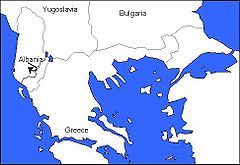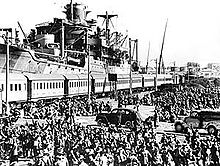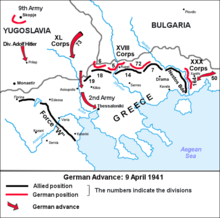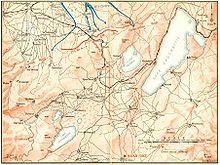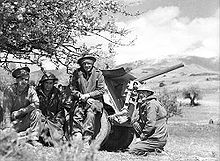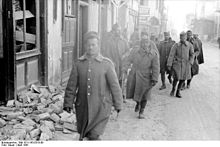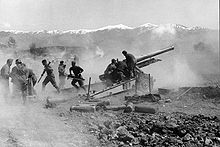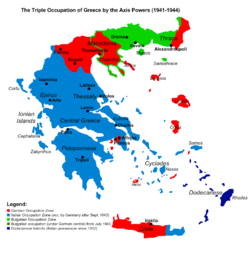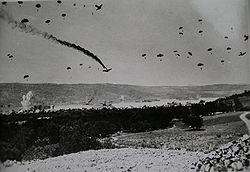- Battle of Greece
-
Battle of Greece Part of the Balkans Campaign during World War II 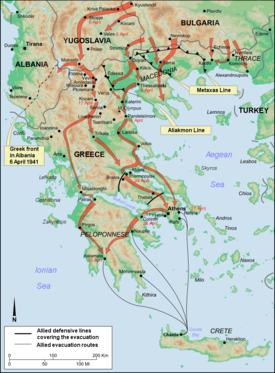
Nazi Germany's attack on Greece.Date 6–30 April 1941 Location Greece Result Decisive Axis victory, occupation of Greece Belligerents Axis:
 Germany
Germany
 Italy
Italy
 Bulgaria
BulgariaAllies:
 Greece
Greece
 United Kingdom
United Kingdom
 Australia
Australia
 New Zealand
New ZealandCommanders and leaders  Wilhelm List
Wilhelm List
 Maximilian von Weichs
Maximilian von Weichs
 Emilio Giglioli
Emilio Giglioli Alexander Papagos
Alexander Papagos
 Henry Maitland Wilson
Henry Maitland Wilson
 Thomas Blamey
Thomas Blamey
 Bernard Freyberg
Bernard FreybergStrength Germany:[1]
680,000 men,
1,200 tanks
700 aircraft
1Italy:[2]
565,000 men
463 aircraft[3]
163 tanks
Total: 1,245,000 men1Greece:[4]
430,000 men, 20 tanks
British Commonwealth:[5]
262,612 men
100 tanks
200-300 aircraftCasualties and losses 1Italy:[6]
13,755 dead,
63,142 wounded,
25,067 missing
1Germany:[7]
1,099 dead,
3,752 wounded,
385 missingBulgaria:[8] at least 400 killed or missing
1Greece:[6]
13,325 dead,
62,663 wounded,
1,290 missing
British Commonwealth:[5]
903 dead,
1,250 wounded,
13,958 captured1Statistics about the strength and casualties of Italy and Greece refer to both the Greco-Italian War and the Battle of Greece (at least 300,000 Greek soldiers fought in Albania[9]). Statistics about Germany's casualties refer to the Balkans Campaign as a whole, and are based on Hitler's statements to the Reichstag on May 4, 1941.[10] 2Including Cypriots and Palestinians. British, Australian and New Zealand troops were c. 58,000.[5]
Balkans CampaignThe Battle of Greece (also known as Operation Marita, German: Unternehmen Marita)[11] is the common name for the invasion and conquest of Greece by Nazi Germany in April 1941. Greece was supported by British Commonwealth forces, while the Germans' Axis allies Italy and Bulgaria played secondary roles. The Battle of Greece is usually distinguished from the Greco-Italian War fought in northwestern Greece and southern Albania from October 1940, as well as from the Battle of Crete fought in late May. These operations, along with the Invasion of Yugoslavia, comprise the Balkans Campaign of World War II.
The Balkans Campaign began with the Italian invasion of Greece on 28 October 1940. Within weeks, the Italians were driven out of Greece and Greek forces pushed on to occupy much of southern Albania. In March 1941, a major Italian counterattack failed, and Germany was forced to come to the aid of its ally. Operation Marita began on 6 April 1941, with German troops invading Greece through Bulgaria in an effort to secure its southern flank. The combined Greek and British Commonwealth forces fought back with great tenacity, but were vastly outnumbered and out-gunned, and finally collapsed. Athens fell on 27 April, however the British managed to evacuate about 50,000 troops.a[›] The Greek campaign ended in a quick and complete German victory with the fall of Kalamata in the Peloponnese; it was over within 24 days. The conquest of Greece was completed through the capture of Crete a month later. Greece remained under occupation by the Axis powers until October 1944.
Some historians regard the German campaign in Greece as decisive in determining the course of World War II, maintaining that it fatally delayed the Axis invasion of the Soviet Union. Others hold that the campaign had no influence on the launching of Operation Barbarossa as monsoon conditions in the Ukraine would have postponed Axis operations regardless. Others believed British intervention in Greece as a hopeless undertaking, a "political and sentimental decision" or even a "definite strategic blunder." It has also been suggested the British strategy was to create a barrier in Greece, to protect Turkey, the only (neutral) country standing between an Axis block in the Balkans and the oil-rich Middle East.[12]
Prelude
Greco-Italian War
For more details on this topic, see Greco-Italian War.“ Hitler always faces me with a fait accompli. This time I am going to pay him back in his own coin. He will find out from the papers that I have occupied Greece. ” —Benito Mussolini, speaking to Count Ciano[13]
At the outbreak of World War II, Ioannis Metaxas—the Prime Minister of Greece—sought to maintain a position of neutrality. However, Greece was increasingly subject to pressure from Italy, which culminated in the Italian submarine Delfino's torpedoing of the Greek cruiser Elli on 15 August 1940.[14] Italian leader Benito Mussolini was irritated that Nazi leader Adolf Hitler had not consulted him on his war policy, and wished to establish his independence.b[›] He hoped to match the military success of the Germans through a victorious attack on Greece, a country he regarded as an easy opponent.[15] On 15 October 1940, Mussolini and his closest advisers finalised their decision to invade Greece.c[›] In the early hours of 28 October, Italian Ambassador Emmanuel Grazzi presented Metaxas with a three-hour ultimatum, in which he demanded free passage for troops to occupy unspecified "strategic sites" within Greek territory.[16] Metaxas rejected the ultimatum (the refusal is commemorated as Ohi Day, a national holiday in Greece), but even before its expiration, Italian troops had invaded Greece through Albania.d[›] The principal Italian thrust was directed towards Epirus, but made little progress. During the Battle of Elaia-Kalamas the Italians fought their way across the Thyamis (Kalamas) river, but were then forced to a halt.[17] Within three weeks, a successful Greek counterattack was underway.[18] A number of towns in southern Albania fell to Greek forces, and neither a change in Italian commanders, nor the arrival of a substantial number of reinforcements had much effect.[19]
After weeks of inconclusive winter warfare, the Italians launched a large-scale counterattack across the centre of the front on 9 March 1941, which, despite the superiority of the Italian armed forces, failed. After one week and 12,000 casualties, Mussolini called off the counterattack, and then left Albania 12 days later.[20] Modern analysts believe that the Italian campaign failed because Mussolini and his generals initially allocated meagre military resources to the campaign (an expeditionary force of 55,000 men),[21] failed to reckon with the autumn weather and launched an attack without the advantage of surprise and without the support of the Bulgarians.[22] Even elementary precautions, such as the issue of winter clothing had not been taken.[23] Nor had Mussolini taken into consideration the recommendations of the Italian Commission of War Production, which had warned that Italy would not be able to sustain a full year of continuous warfare until 1949.[24]
During the six month fight against Italy, the Greek army made local gains by eliminating enemy salients. Nevertheless, Greece did not have a substantial armaments industry, and both its equipment and ammunition supplies increasingly relied on stocks captured by British forces from defeated Italian armies in North Africa. In order to man the battlefront in Albania, the Greek command was forced to make withdrawals from Eastern Macedonia and Western Thrace. Anticipation of a German attack expedited the need to reverse the position; the available forces were proving unable to sustain resistance on both fronts. The Greek command decided to support its success in Albania, regardless of how the situation might develop under the impact of a German attack from the Bulgarian border.[25]
First Italian offensive
October 28 – November 13, 1940.Greek counter-offensive
November 14, 1940 – March, 1941.Second Italian offensive
March 9 – April 23, 1941.Hitler's decision to attack and British aid to Greece
I wanted, above all to ask you to postpone the operation until a more favorable season, in any case until after the presidential election in America. In any event I wanted to ask you not to undertake this action without previously carrying out a blitzkrieg operation on Crete. For this purpose I intended to make practical suggestions regarding the employment of a parachute and an airborne division.
From a letter Adolf Hitler addressed to Mussolini on November 20, 1940[26]Hitler intervened on 4 November 1940, four days after the British took both Crete and Lemnos. The Führer ordered his Army General Staff to prepare for an invasion of Northern Greece via Romania and Bulgaria. His plans for this campaign were incorporated into a master plan aimed at depriving the British of their Mediterranean bases.[27] On 12 November, the German Armed Forces High Command issued Directive No. 18, in which they scheduled simultaneous operations against Gibraltar and Greece for the following January. However, in December 1940, German ambition in the Mediterranean underwent considerable revision when Spain's General Francisco Franco rejected plans for an attack on Gibraltar.[28] Consequently, Germany's offensive in Southern Europe was restricted to the campaign against Greece. The Armed Forces High Command issued Directive No. 20 on 13 December 1940. The document outlined the Greek campaign under the code designation "Operation Marita", and planned for German occupation of the northern coast of the Aegean Sea by March 1941. It also planned for the seizure of the entire Greek mainland, if that became necessary.[29] During a hastily called meeting of Hitler's staff after the unexpected 27 March coup d'état against the Yugoslav government, orders for the future campaign in Yugoslavia were drafted, as well as changes to the plan for the attack on Greece. On 6 April, both Greece and Yugoslavia were to be attacked.[30]
The Yugoslav coup came suddenly out of the blue. When the news was brought to me on the morning of the 27th I thought it was a joke.
Hitler speaking to his Commanders-in-Chief[31]Britain was obliged to assist Greece by the declaration of 1939, which stated that in the event of a threat to Greek or Romanian independence, "His Majesty's Government would feel themselves bound at once to lend the Greek or Romanian Government [...] all the support in their power."[32] The first British effort was the deployment of Royal Air Force squadrons commanded by Air Commodore John d'Albiac, which were sent in November 1940.[33] With the consent of the Greek government, British forces were dispatched to Crete on 31 October to guard Suda Bay, enabling the Greek government to redeploy the 5th Cretan Division to the mainland.[34]
On 17 November 1940, Metaxas proposed to the British government the undertaking of a joint offensive in the Balkans with the Greek strongholds in southern Albania as the base of the operations. The British were reluctant to discuss Metaxas' proposal, because the deployment of troops necessary for implementing the Greek plan would seriously endanger the Commonwealth military operations in North Africa.[35] During a meeting of British and Greek military and political leaders in Athens on 13 January 1941, General Alexandros Papagos—Commander-in-Chief of the Hellenic Army—asked Britain for nine fully equipped divisions and corresponding air support. The British responded that, because of their commitment to the fight in North Africa, all they could offer was the immediate dispatch of a small token force of less than divisional strength. This offer was rejected by the Greeks who feared that the arrival of such a contingent would precipitate a German attack without giving them any sizable assistance.e[›] British help would be requested if and when German troops crossed the Danube from Romania into Bulgaria.[36]
British expeditionary force
We did not then know that he [Hitler] was already deeply set upon his gigantic invasion of Russia. If we had we should have felt more confidence in the success of our policy. We should have seen that he risked falling between two stools, and might easily impair his supreme undertaking for the sake of a Balkan preliminary. This is what actually happened, but we could not know that at the time. Some may think we builded rightly; at least we builded better than we knew at the time. It was our aim to animate and combine Yugoslavia, Greece, and Turkey. Our duty so far as possible was to aid the Greeks.
Winston Churchill[37]Churchill held to his ambition to recreate a Balkan Front comprising Yugoslavia, Greece and Turkey,[37] and instructed Anthony Eden and Sir John Dill to resume negotiations with the Greek government. A meeting attended by Eden and the Greek leadership, including King George II, Prime Minister Alexandros Koryzis—the successor of Metaxas, who had died on 29 January 1941—and Papagos took place in Athens on 22 February. There the decision to send a British Commonwealth expeditionary force was made.[38] German troops had been massing in Romania and on 1 March 1941, Wehrmacht forces began to move into Bulgaria. At the same time, the Bulgarian Army mobilised and took up positions along the Greek frontier.[37]
On 2 March, Operation Lustre—the transportation of troops and equipment to Greece—began and 26 troopships arrived at the port of Piraeus.[39] On 3 April, during a meeting of British, Yugoslav, and Greek military representatives, the Yugoslavs promised to block the Strymon valley in case of a German attack across their territory.[40] During this meeting, Papagos laid stress on the importance of a joint Greco-Yugoslavian offensive against the Italians, as soon as the Germans launched their offensive against the two countries.f[›] Until 24 April, more than 62,000 Commonwealth troops (British, Australians, New Zealanders, Palestinians and Cypriots), were sent to Greece, comprising the 6th Australian Division, the New Zealand 2nd Division, and the British 1st Armoured Brigade.[41] The three formations later became known as 'W' Force, after their commander, Lieutenant-General Sir Henry Maitland Wilson.g[›] Air Commodore Sir John D'Albiac commanded the British air forces in Greece.[42]
Military preparations
Topography
To enter Northern Greece, the German army was compelled to cross the Rhodope mountains, which possessed few river valleys or passes capable of accommodating the movement of large military units. Two invasion courses were located west of Kyustendil; another was along the Yugoslav-Bulgarian border, via the Strimon valley to the south. Greek border fortifications had been adapted for the terrain, and a formidable defence system covered the few available roads. The Strimon and Nestos rivers cut across the mountain range along the Greek-Bulgarian frontier, and both of their valleys were protected by strong fortifications, as part of the larger Metaxas Line. This system of concrete pillboxes and field fortifications was constructed along the Bulgarian border in the late 1930s, and was based on principles similar to those applied to the Maginot Line. Its strength resided mainly in the inaccessibility of the intermediate terrain leading up to the defence positions.[43]
Strategic factors
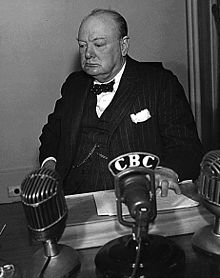 Winston Churchill believed it was vital for Britain to take every measure possible to support Greece. On 8 January 1941, he stated that "there was no other course open to us but to make certain that we had spared no effort to help the Greeks who had shown themselves so worthy."[44]
Winston Churchill believed it was vital for Britain to take every measure possible to support Greece. On 8 January 1941, he stated that "there was no other course open to us but to make certain that we had spared no effort to help the Greeks who had shown themselves so worthy."[44]
The mountainous terrain of Greece favored a defensive strategy, and the high ranges of the Rhodope, Epirus, Pindus, and Olympus mountains offered many opportunities to stop an invader. However, adequate air power was required to prevent defending ground forces from becoming trapped in the many defiles. Although an invading force from Albania could be stopped by a relatively small number of troops positioned in the high Pindus mountains, the northeastern part of the country was difficult to defend against an attack from the north.[45]
Following a conference in Athens that March, the British command believed that they would combine with Greek forces to occupy the Haliacmon Line—a short front facing northeastward along the Vermion Mountains, and the lower Haliacmon river. Papagos awaited clarification from the Yugoslav government, and later proposed to hold the Metaxas Line—by then a symbol of national security to the Greek populace—and not withdraw any of his divisions from Albania.[46] He argued that to do so would be seen as a concession of victory to the Italians. The strategically important port of Thessaloniki lay practically indefensible, and transportation of British troops to the city remained dangerous.[47] Papagos proposed to take advantage of the area's difficult terrain and prepare fortifications, while at the same time protecting Thessaloniki.
General Dill described Papagos' attitude as "unaccommodating and defeatist",[48] and argued that his plan disregarded the fact that Greek troops and artillery were capable of only token resistance. The British believed that the Greek rivalry with Bulgaria—the Metaxas Line was designed specifically for use in the event of war with Bulgaria—as well as their traditionally good terms with the Yugoslavs, left their north-western border largely undefended.[49] Despite their concerns over the vulnerability of the border system, and their awareness that it was likely to collapse in the event of a German thrust from the Strimon and Axios rivers, the British eventually conceded to the Greek command. On 4 March, Dill accepted the plans for the Metaxas line, and on 7 March, agreement was ratified by the British Cabinet.[50] The overall command was to be retained by Papagos, and the Greek and British commands resigned themselves to fighting a delaying action in the northeastern part of the country.[45] Nevertheless, the British did not move their troops, because General Wilson regarded them as too weak to maintain such a broad front line. Instead, he took a position some 40 mi (64 km) west of the Axios, across the Haliacmon Line.[51] The two main objectives in establishing this position were to maintain contact with the Greek army in Albania, and to deny German access to Central Greece. This had the advantage of requiring a smaller force than other options, while still allowing more time for preparation. However, it meant abandoning nearly the whole of Northern Greece, and was thus unacceptable to the Greeks for both political and psychological reasons. Moreover, the left flank of the line was susceptible to flanking from Germans operating through the Monastir gap in Yugoslavia.[52] However, the possibility of a rapid disintegration of the Yugoslav Army, and a German thrust into the rear of the Vermion position, was not taken into consideration.[45]
The German strategy was based on utilisation of the so-called "blitzkrieg" methods which had proved successful during the invasions of Western Europe, and confirmed their effectiveness during the invasion of Yugoslavia. The German command planned to couple an attack of ground troops and tanks with support from the air, and make a rapid thrust into the territory. Once Thessaloniki was captured, Athens and the port of Piraeus would be the next principal targets. With Piraeus and the Isthmus of Corinth in German hands, the withdrawal and evacuation of British and Greek forces would be fatally compromised.[45]
Defence and attack forces
 Lieutenant General Sir Thomas Blamey, commander of Australian I Corps, Lieutenant General Sir Henry Maitland Wilson, commanding general of the Commonwealth expeditionary force ('W' Force), and Major General Bernard Freyberg, commander of the New Zealand 2nd Division, in 1941 in Greece. (Australian War Memorial, Canberra)
Lieutenant General Sir Thomas Blamey, commander of Australian I Corps, Lieutenant General Sir Henry Maitland Wilson, commanding general of the Commonwealth expeditionary force ('W' Force), and Major General Bernard Freyberg, commander of the New Zealand 2nd Division, in 1941 in Greece. (Australian War Memorial, Canberra)
The Fifth Yugoslav Army was given responsibility for the defence of the southeastern border between Kriva Palanka and the Greek border. At the time of the German attack, the Yugoslav troops were not yet fully mobilised, they also lacked a sufficient amount of modern equipment or weapons to be fully effective. Following the entry of German forces into Bulgaria, the majority of Greek troops were evacuated from Western Thrace. By this time, the total strength of the Greek forces defending the Bulgarian border totaled roughly 70,000 men (sometimes grouped as the "Greek Second Army" in English and German sources, although no such formation existed). The remainder of the Greek forces—14 divisions (often erroneously referred to as the "Greek First Army" by foreign sources)—was committed in Albania.[53]
On 28 March, the Greek forces in Central Macedonia—the 12th and 20th Infantry Divisions—were put under the command of General Wilson, who established his headquarters northwest of Larissa. The New Zealand division took a position north of Mount Olympus, while the Australian division blocked the Haliacmon valley up to the Vermion range. The Royal Air Force continued to operate from airfields in Central and Southern Greece; however, few planes could be diverted to the theater. The British forces were near to fully motorised, but their equipment was more suited to desert warfare than to the steep mountain roads of Greece. There was a shortage of tanks and anti-aircraft guns, and the lines of communication across the Mediterranean were vulnerable, because each convoy had to pass close to enemy-held islands in the Aegean; despite the fact that the British Royal Navy dominated the Aegean Sea. These logistical problems were aggravated by the limited availability of shipping and capacity of the Greek ports.[54]
The German Twelfth Army—under the command of Field Marshal Wilhelm List—was charged with the execution of Operation Marita. His army was composed of six units:
- First Panzer Group, under the command of General Ewald von Kleist.
- XL Panzer Corps, under Lieutenant General Georg Stumme.
- XVIII Mountain Corps, under Lieutenant General Franz Böhme.
- XXX Infantry Corps, under Lieutenant General Otto Hartmann.
- L Infantry Corps, under Lieutenant General Georg Lindemann.
- 16th Panzerdivision, deployed behind the Turkish-Bulgarian border to support the Bulgarian forces in case of a Turkish attack.[55]
German plan of attack and assembly
The German plan of attack was formulated and influenced by their army's experiences during the Battle of France. Their strategy was to create a diversion through the campaign in Albania, thus stripping the Greek Army of sufficient manpower for the defence of their Yugoslavian and Bulgarian borders. By driving armoured wedges through the weakest links of the defence chain, the ability to penetrate into enemy territory would be more easily achieved, and would not necessitate the maneuver of their armour behind an infantry advance. Once the weak defence systems of Southern Yugoslavia were overrun by German armour, the Metaxas Line could be outflanked by highly mobile forces thrusting southward from Yugoslavia. Thus possession of Monastir and the Axios valley leading to Thessaloniki became essential for such an outflanking maneuver.[56]
The Yugoslav coup d'état led to a sudden change in the plan of attack, and confronted the Twelfth Army with a number of difficult problems. According to the 28 March Directive No. 25, the Twelfth Army was to regroup its forces in such a manner that a mobile task force would be available to attack via Niš toward Belgrade. With only nine days left before their final deployment, every hour became valuable, and each fresh assembly of troops would need time to mobilise. By the evening of 5 April, each attack force intended to enter either southern Yugoslavia or Greece had been assembled.[57]
German invasion
Thrust across Southern Yugoslavia and the drive to Thessaloniki
At dawn on 6 April, the German armies invaded Greece, while the Luftwaffe began an intensive bombardment of Belgrade. The XL Panzer Corps—which had been intended for use in an attack across southern Yugoslavia—began their assault at 05:30. They also made thrusts across the Bulgarian frontier at two separate points. By the evening of 8 April, the 73rd Infantry Division captured Prilep, severing an important rail line between Belgrade and Thessaloniki and isolating Yugoslavia from its allies. The Germans were now in possession of terrain which was favorable to the continuation of the offensive. On the evening of 9 April, General Stumme deployed his forces north of Monastir, in preparation for the extension of the attack across the Greek border toward Florina. This position threatened to encircle the Greeks in Albania and W Force in the area of Florina, Edessa, and Katerini.[58] While weak security detachments covered the rear of his corps against a surprise attack from central Yugoslavia, elements of the 9th Panzerdivision drove westward to link up with the Italians at the Albanian border.[59]
The 2nd Panzerdivision (XVIII Mountain Corps) entered Yugoslavia from the east on the morning of 6 April, and advanced westward through the Struma Valley. It encountered little enemy resistance, but was delayed by road clearance demolitions, mines, and muddy roads. Nevertheless, the division was able to reach the objective of the day, the town of Strumica. On 7 April, a Yugoslav counter attack against the northern flank of the division was repelled, and the following day the division forced its way across the mountains and overran the Greek 19th Motorised Infantry Division Units stationed south of Doiran lake. Despite many delays along the narrow mountain roads, an armoured advance guard dispatched in the direction of Thessaloniki succeeded in entering the city by the morning of April 9.[60] Thessaloniki's capture took place without a struggle, and was followed by the surrender of the Greek East Macedonia Army Section, taking effect at 13:00 on 10 April.
Metaxas Line
For more details on this topic, see Battle of Metaxas Line.The Metaxas Line was defended by the Eastern Macedonia Army Section, which comprised the 7th, 14th and 18th Infantry Divisions under the command of Lieutenant General Konstantinos Bakopoulos. The line ran for about 170 km (110 mi) along the river Nestos to the east, and then further to the east following the Bulgarian border as far as Mount Beles near the Yugoslav border. The fortifications were designed to garrison an army of over 200,000 troops, but due to a lack of available manpower, the actual number was roughly 70,000. As a result of the low numbers, the line's defences were thinly spread.[61]
The initial German attacks against the line were undertaken by a single German infantry unit reinforced by two mountain divisions of the XVIII Mountain Corps. These first forces encountered strong resistance, and had limited success.[62] A German report at the end of the first day described how the German 5th Mountain Division "was repulsed in the Rupel Pass despite strongest air support and sustained considerable casualties".[63] Of the 24 forts which made up the Metaxas Line, only two had fallen, and then only after they had been destroyed.[64] Most fortresses—including Rupel, Echinos, Arpalouki, Paliouriones, Perithori, Karadag, Lisse and Istibey—resisted for three days.[65]
The line was penetrated following a three-day struggle during which the Germans pummeled the forts with artillery and dive bombers. The main credit for this achievement must be given to the 6th Mountain Division, which crossed a 7,000 ft (2,100 m) snow-covered mountain range and broke through at a point that had been considered inaccessible by the Greeks. The force reached the rail line to Thessaloniki on the evening of 7 April. The other XVIII Mountain Corps units advanced step by step under great hardship. The 5th Division, together with the reinforced 125th Infantry Regiment, penetrated the Strimon defences on 7 April and attacked along both banks of the river, clearing one bunker after another as they passed. Nevertheless the unit suffered heavy casualties, to the extent that it was withdrawn from further action after it had reached its objective location. The 72nd Infantry Division advanced from Nevrokop across the mountains, and although it was handicapped by a shortage of pack animals, medium artillery, and mountain equipment, managed to break through the Metaxas Line on the evening of 9 April, when it reached the area northeast of Serres.[66] Even after General Bakopoulos surrendered the Metaxas Line, isolated fortresses held out for days, and were not taken until heavy artillery was used against them. Some field troops and soldiers manning the frontier continued to fight on, as a result a number were able to evacuate by sea.[67]
Capitulation of the Greek army in Macedonia
The XXX Infantry Corps on the left wing reached its designated objective on the evening of 8 April, when the 164th Infantry Division captured Xanthi. The 50th Infantry Division advanced far beyond Komotini towards the Nestos river, which both divisions reached on the next day. On 9 April, the Greek forces defending the Metaxas Line capitulated unconditionally following the collapse of Greek resistance east of the Axios river. In an 9 April estimate of the situation, Field Marshal List expressed the opinion that as a result of the swift advance of the mobile units, his 12th Army was now in a favorable position to gain access to central Greece by breaking the enemy buildup behind the Axios river. On the basis of this estimate, List requested the transfer of the 5th Panzer Division from First Panzer Group to the XL Panzer Corps. He reasoned that its presence would give additional punch to the German thrust through the Monastir gap. For the continuation of the campaign, he formed two attack groups, an eastern one under the command of XVIII Mountain Corps, and a western group led by XL Panzer Corps.[68]
Breakthrough to Kozani
See also: Battle of Vevi (1941)By the morning of 10 April, the XL Panzer Corps had finished its preparations for the continuation of the offensive, and continued the advance in the direction of Kozani. Against all expectations, the Monastir gap had been left open, and the Germans exploited their chance. First contact with Allied troops was made north of Vevi at 11:00 on 10 April. SS troops seized Vevi on 11 April, but were stopped at the Klidi Pass just south of the town, where a mixed Commonwealth-Greek formation—known as Mackay Force—was assembled to, as Wilson put it, "....stop a blitzkrieg down the Florina valley."[69] During the next day, the SS regiment reconnoitered the enemy positions, and at dusk launched a frontal attack against the pass. Following heavy fighting, the Germans overcame the enemy resistance, and broke through the defence.[70] By the morning of 14 April, the spearheads of the 9th Panzer Division reached Kozani.
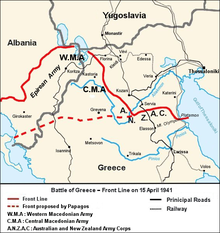 Front line on April 15, 1941
Front line on April 15, 1941
Olympus and Servia passes
Wilson faced the prospect of being pinned by Germans operating from Thessaloniki, while being flanked by the German XL Panzer Corps descending through the Monastir Gap. On 13 April, he decided to withdraw all British forces to the Haliacmon river, and then to the narrow pass at Thermopylae.[71] On 14 April, the 9th Panzerdivision established a bridgehead across the Haliacmon river, but an attempt to advance beyond this point was stopped by intense enemy fire. This defence had three main components: the Platamon tunnel area between Olympus and the sea, the Olympus pass itself, and the Servia pass to the southeast. By channelling the attack through these three defiles, the new line offered far greater defensive strength for the limited forces available. The defences of the Olympus and Servia passes consisted of the 4th New Zealand Brigade, 5th New Zealand Brigade, and the 16th Australian Brigade. For the next three days, the advance of the 9th Panzer Division was stalled in front of these resolutely held positions.[72]
A ruined castle dominated the ridge across which the coastal pass led to Platamon. During the night of 15 April, a German motorcycle battalion supported by a tank battalion attacked the ridge, but the Germans were repulsed by the 21st New Zealand Battalion under Colonel Macky, which suffered heavy losses in the process. Later that day a German armoured regiment arrived and struck the coastal and inland flanks of the battalion, but the New Zealanders held their ground. After being reinforced during the night of the 15th-16th, the Germans managed to assemble a tank battalion, an infantry battalion, and a motorcycle battalion. The German infantry attacked the New Zealanders' left company at dawn, while the tanks attacked along the coast several hours later.[73]
The New Zealand battalion withdrew, crossed the Pineios river; by dusk, they had reached the western exit of the Pineios Gorge, suffering only light casualties.[73] Macky was informed that it was "essential to deny the gorge to the enemy until April 19 even if it meant extinction".[74] He sank a crossing barge at the western end of the gorge once all his men were across and began to set up defences. The 21st battalion was reinforced by the Australian 2/2nd Battalion and later by the 2/3rd, this force became known as "Allen force" after Brigadier "Tubby" Allen. The 2/5th and 2/11th battalions moved to the Elatia area south-west of the gorge and were ordered to hold the western exit possibly for three or four days.[75]
On 16 April, General Wilson met General Papagos at Lamia and informed him of his decision to withdraw to Thermopylae. General Blamey divided responsibility between generals Mackay and Freyberg during the leapfrogging move back to Thermopylae. Mackay would protect the flanks of the New Zealand Division as far south as an east-west line through Larissa and would control the withdrawal through Domokos to Thermopylae of the Savige and Zarkos Forces, and finally of Lee Force; the 1st Armoured Brigade would cover the withdrawal of Savige Force to Larissa and thereafter the withdrawal of the 6th Division under whose command it would come; Freyberg would control the withdrawal of Allen Force which was to move along the same route as the New Zealand Division. The British Commonwealth forces remained under constant attack throughout the entire withdrawal.[76]
On the morning of 18 April, the struggle for the Pineios gorge was over, when German armoured infantry crossed the river on floats and the 6th Mountain Division troops worked their way around the New Zealand battalion, which was subsequently dispersed. On 19 April, the first XVIII Mountain Corps troops entered Larissa and took possession of the airfield, where the British had left their supply dumps intact. The seizure of ten truckloads of rations and fuel enabled the spearhead units to continue their drive without ceasing. The port of Volos, at which the British had re-embarked numerous units during the last few days, fell on 21 April; there, the Germans captured large quantities of valuable diesel and crude oil.[77]
Withdrawal and surrender of the Greek Epirus Army
As the invading Germans advanced deep into Greek territory, the Greek Army Section of Epirus (ΤΣΗ) operating in Albania was reluctant to retreat. General Wilson described this unwillingness as "the fetishistic doctrine that not a yard of ground should be yielded to the Italians."[78] It was not until 13 April that the first Greek elements began to withdraw toward the Pindus mountains. The Allies' retreat to Thermopylae uncovered a route across the Pindus mountains by which the Germans might flank the Greek army in a rearguard action. An elite SS formation—the Leibstandarte SS Adolf Hitler brigade—was assigned the mission of cutting off the Greek Epirus Army's line of retreat from Albania by driving westward to the Metsovon pass, and from there to Ioannina.[79] On 14 April, heavy fighting took place at Kleisoura pass, where the Germans blocked the Greek withdrawal. The withdrawal extended across the entire Albanian front, with the Italians in hesitant pursuit.[80]
General Papagos rushed Greek units to the Metsovon pass where the Germans were expected to attack. On 18 April, a pitched battle between several Greek units and the LSSAH brigade—which had by then reached Grevena—erupted.[80] The Greek units lacked the equipment necessary to fight against a motorised unit, and were soon encircled and overwhelmed. The Germans advanced further and on 19 April captured Ioannina, the final supply route of the Greek Epirus Army.[81] Allied newspapers dubbed the Greek army's fate as a modern day Greek tragedy. Historian and former war-correspondent Christopher Buckley—when describing the fate of the Greek army—stated that "one experience[d] a genuine Aristotelian catharsis, an awe-inspiring sense of the futility of all human effort and all human courage."[82]
On 20 April, the commander of the Greek forces in Albania—General Georgios Tsolakoglou—realised the hopelessness of the situation and offered to surrender his army, which then consisted of fourteen divisions.[80] World War II historian John Keegan writes that Tsolakoglou "was so determined [...] to deny the Italians the satisfaction of a victory they had not earned that [...] he opened [a] quite unauthorised parley with the commander of the German SS division opposite him, Sepp Dietrich, to arrange a surrender to the Germans alone."[83] On strict orders from Hitler negotiations were kept secret from the Italians, and the surrender was accepted.[80] Outraged by this decision Mussolini ordered counterattacks against the Greek forces, which were repulsed. It took personal representation from Mussolini to Hitler to bring together an armistice in which Italy was included on 23 April.[84] Greek soldiers were not treated as prisoners of war and were allowed instead to go home after the demobilisation of their units, while their officers were permitted to retain their side arms.[85]
Thermopylae position
For more details on this topic, see Battle of Thermopylae (1941).As early as 16 April, the German command realised that the British were evacuating troops on ships at Volos and Piraeus. The whole campaign had taken on the character of a pursuit. For the Germans, it was now primarily a question of maintaining contact with the retreating British forces, and foiling their evacuation plans. German infantry divisions were withdrawn from action due to a lack of mobility. The 2nd and 5th Panzerdivisions, the 1st SS Motorised Infantry Regiment and both mountain divisions launched a pursuit of the enemy forces.[86]
To allow an evacuation of the main body of British forces, Wilson ordered the rear guard to make a last stand at the historic Thermopylae pass, the gateway to Athens. General Freyberg was given the task of defending the coastal pass, while Mackay was to hold the village of Brallos. After the battle Mackay was quoted as saying "I did not dream of evacuation; I thought that we'd hang on for about a fortnight and be beaten by weight of numbers."[87] When the order to retreat was received on the morning of 23 April, it was decided that each of the two positions was to be held by one brigade each. These brigades, the Australian 19th and 6th New Zealand were to hold the passes as long as possible, allowing the other units to withdraw. The Germans attacked at 11:30 on 24 April, met fierce resistance, lost 15 tanks and sustained considerable casualties.[88] The Allies held out the entire day; with the delaying action accomplished, they retreated in the direction of the evacuation beaches and set up another rearguard at Thebes.[89] The Panzer units launching a pursuit along the road leading across the pass made slow progress because of the steep gradient and a large number of difficult hairpin bends.[90]
German drive on Athens
The quarrel over the troops' victorious entry into Athens was a chapter to itself: Hitler wanted to do without a special parade, to avoid injuring Greek national pride. Mussolini, alas, insisted on a glorious entry into the city for his Italian troops. The Führer yielded to the Italian demand and together the German and Italian troops marched into Athens This miserable spectacle, laid on by our gallant ally, must have produced some hollow laughter from the Greeks.
Wilhelm Keitel[91]After abandoning the Thermopylae area, the British rear guards withdrew to an improvised switch position south of Thebes, where they erected a last obstacle in front of Athens. The motorcycle battalion of the 2nd Panzerdivision, which had crossed to the island of Euboea to seize the port of Chalcis, and had subsequently returned to the mainland, was given the mission of outflanking the British rear guard. The motorcycle troops encountered only slight resistance, and on the morning of 27 April 1941, the first Germans entered Athens, followed by armoured cars, tanks, and infantry. They captured intact large quantities of POL (petroleum, oil and lubricants) several thousand tons of ammunition, ten trucks loaded with sugar and ten truckloads of other rations in addition to various other equipment, weapons, and medical supplies.[92] The people of Athens had been expecting the Germans to enter the city for several days and kept themselves confined to their homes with their windows shut. The previous night, Athens Radio had made the following announcement:
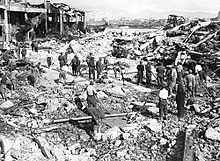 Damage from the German bombing of Piraeus on 6 April 1941(Australian War Memorial, Canberra). During the bombing, a ship carrying nitroglycerin was hit, causing a huge explosion.[93]
Damage from the German bombing of Piraeus on 6 April 1941(Australian War Memorial, Canberra). During the bombing, a ship carrying nitroglycerin was hit, causing a huge explosion.[93]
"You are listening to the voice of Greece. Greeks, stand firm, proud, and dignified. You must prove yourselves worthy of your history. The valor and victory of our army has already been recognised. The righteousness of our cause will also be recognised. We did our duty honestly. Friends! Have Greece in your hearts, live inspired with the fire of her latest triumph and the glory of our army. Greece will live again and will be great, because she fought honestly for a just cause and for freedom. Brothers! Have courage and patience. Be stouthearted. We will overcome these hardships. Greeks! With Greece in your minds you must be proud and dignified. We have been an honest nation and brave soldiers."[94]
The Germans drove straight to the Acropolis and raised the Nazi flag. According to the most popular account of the events, the Evzone soldier on guard duty, Konstantinos Koukidis, took down the Greek flag, refusing to hand it to the invaders wrapped himself in it, and jumped off the Acropolis.[95] Whether the story was true or not, many Greeks believed it and viewed the soldier as a martyr.[89]
Evacuation of Commonwealth forces
Little news from Greece, but 13,000 men got away to Crete on Friday night, and so there are hopes of a decent percentage of evacuation. It is a terrible anxiety [...] War Cabinet. Winston says "We will lose only 5,000 in Greece." We will in fact lose at least 15,000. W. is a great man, but he is more addicted to wishful thinking every day.
Robert Menzies, Excerpts from his personal diary, April 27 and 28, 1941[96]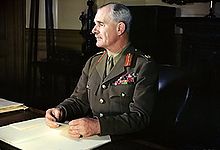 In the morning of 15 April 1941, Wavell sent to Wilson the following message: "We must of course continue to fight in close cooperation with Greeks but from news here it looks as if early further withdrawal necessary."[97]
In the morning of 15 April 1941, Wavell sent to Wilson the following message: "We must of course continue to fight in close cooperation with Greeks but from news here it looks as if early further withdrawal necessary."[97]
General Archibald Wavell—the commander of British Army forces in the Middle East, when in Greece from 11-13 April—had warned Wilson that he must expect no reinforcements, and had authorised Major General Freddie de Guingand to discuss evacuation plans with certain responsible officers. Nevertheless, the British could not at this stage adopt or even mention this course of action; the suggestion had to come from the Greek Government. The following day Papagos made the first move when he suggested to Wilson that W Force should be withdrawn. Wilson informed Middle East Headquarters, and on 17 April Rear admiral H. T. Baillie-Grohman was sent to Greece to prepare for the evacuation.[98] That day Wilson hastened to Athens where he attended a conference with the King, Papagos, d'Albiac and Rear admiral Turle. In the evening, Koryzis after telling the King that he felt he had failed him in the task entrusted to him, committed suicide.[99] On 21 April, the final decision for the evacuation of the Commonwealth forces to Crete and Egypt was taken, and Wavell—in confirmation of verbal instructions—sent his written orders to Wilson.[100]
5,200 men, most of which belonged to the 5th New Zealand Brigade were evacuated on the night of 24 April from Porto Rafti of East Attica, while the 4th New Zealand Brigade remained to block the narrow road to Athens, which was dubbed the 24 Hour Pass by the New Zealanders.[101] On 25 April (Anzac Day), the few RAF squadrons left Greece (d'Albiac established his headquarters in Heraklion, Crete), and some 10,200 Australian troops were evacuated from Nauplion and Megara.[102] 2,000 more men had to wait until 27 April, because Ulster Prince ran aground in shallow waters close to Nauplion. Because of this event, the Germans realised that the evacuation was also taking place from the ports of East Peloponnese.[103]
We cannot remain in Greece against wish of Greek Commander-in-Chief, and thus expose country to devastation. Wilson or Palairet should obtain endorsement by Greek Government of Papagos' request. Consequent upon this assent, evacuation should proceed, without however prejudicing any withdrawal to Thermopylae position in co-operation with the Greek Army. You will naturally try to save as much material as possible.
Churchill's response to the Greek proposal on April 17, 1941[104]On 25 April, the Germans staged an airborne operation to seize the bridges over the Corinth canal, with the double aim of both cutting off the British line of retreat and securing their own way across the isthmus. The attack met with initial success, until a stray British shell destroyed the bridge.[105] The 1st SS Motorised Infantry Regiment (LSSAH), assembled at Ioannina, thrust along the western foothills of the Pindus Mountains via Arta to Missolonghi, and crossed over to the Peloponnese at Patras in an effort to gain access to the isthmus from the west. Upon their arrival at 17:30 on 27 April, the SS forces learned that the paratroops had already been relieved by Army units advancing from Athens.[92]
The erection of a temporary bridge across the Corinth canal permitted 5th Panzerdivision units to pursue the enemy forces across the Peloponnese. Driving via Argos to Kalamata, from where most Allied units had already begun to evacuate, they reached the south coast on 29 April, where they were joined by SS troops arriving from Pyrgos.[92] The fighting on the Peloponnese consisted merely of small-scale engagements with isolated groups of British troops who had been unable to make ship in time. The attack came a few days too late to cut off the bulk of the British troops in Central Greece, but did manage to isolate the Australian 16th and 17th Brigades.[106] By 30 April, the evacuation of about 50,000 soldiers was completed,a[›] but was heavily contested by the German Luftwaffe, which sank at least 26 troop-laden ships. The Germans captured around 8,000 Commonwealth (including 2,000 Cypriots and Palestinians) and Yugoslav troops in Kalamata who had not been evacuated, while liberating many Italian prisoners from POW camps.[107]
Aftermath
Triple occupation
For more details on this topic, see Axis occupation of Greece during World War II.On 13 April 1941, Hitler issued his Directive No. 27, which illustrated his future occupying policy in Greece.[108] He finalised jurisdiction in the Balkans with his Directive No. 31 issued on 9 June.[109] Mainland Greece was divided between Germany, Italy, and Bulgaria. German forces occupied the strategically more important areas, namely Athens, Thessaloniki with Central Macedonia, and several Aegean islands, including most of Crete. They also occupied Florina, which was claimed by both Italy and Bulgaria.[110] On the same day that Tsolakoglou offered his surrender, the Bulgarian Army invaded Thrace. The goal was to gain an Aegean Sea outlet in Western Thrace and Eastern Macedonia. The Bulgarians occupied territory between the Strimon river and a line of demarcation running through Alexandroupoli and Svilengrad west of the Evros river.[111] The remainder of Greece was left to Italy. Italian troops started occupying the Ionian and Aegean islands on 28 April. On 2 June, they occupied the Peloponnese; on 8 June, Thessaly; and on 12 June, most of Attica.[109]
The occupation of Greece—during which civilians suffered terrible hardships, many died from privation and hunger—proved to be a difficult and costly task. It led to the creation of several resistance groups, which launched guerilla attacks against the occupying forces and set up espionage networks.[112]
Battle of Crete
German paratroopers land in Crete.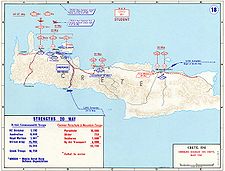
Map of the German assault on Crete.For more details on this topic, see Battle of Crete.On 25 April 1941, King George II and his government left the Greek mainland for Crete, which was attacked by Nazi forces on 20 May 1941.[113] The Germans employed parachute forces in a massive airborne invasion, and launched their offensive against three main airfields of the island in Maleme, Rethymno, and Heraklion. After seven days of fighting and tough resistance, Allied commanders decided that the cause was hopeless, and ordered a withdrawal from Sfakia. By 1 June 1941, the evacuation of Crete by the Allies was complete and the island was under German occupation. In light of the heavy casualties suffered by the elite 7th Fliegerdivision, Hitler forbade further airborne operations.[114] General Kurt Student would dub Crete "the graveyard of the German paratroopers" and a "disastrous victory."[114] During the night of 24 May, George II and his government were evacuated from Crete to Egypt.[38]
Assessments
Battle of Greece Timeline April 6, 1941 The German armies invade Greece. April 8, 1941 The German 164th Infantry Division captures Xanthi. April 9, 1941 German troops seize Thessaloniki.
The German 72nd Infantry Division breaks through the Metaxas Line.
The Greek army in Macedonia capitulates unconditionally.April 10, 1941 The Germans overcome the enemy resistance north of Vevi, at the Klidi Pass. April 13, 1941 General Wilson decides to withdraw all British forces to the Haliacmon river, and then to Thermopylae.
Elements of the Greek First Army operating in Albania withdraw toward the Pindus mountains.
Hitler issues his Directive No. 27, which illustrates his future occupying policy in Greece.April 14, 1941 The spearheads of the 9th Panzer Division reach Kozani.
After fighting at Kastoria pass, the Germans block the Greek withdrawal, which extends across the entire Albanian front.April 16, 1941 Wilson informs General Papagos of his decision to withdraw to Thermopylae. April 17, 1941 Rear admiral H. T. Baillie-Grohman is sent to Greece to prepare for the evacuation of the Commonwealth forces. April 18, 1941 After a three-days struggle, German armored infantry crosses the Pineios river.
The 1st SS Division Leibstandarte SS Adolf Hitler—which had reached Grevena— overwhelms several Greek units.April 19, 1941 German troops enter Larissa and take possession of the airfield.
German troops capture Ioannina.April 20, 1941 The commander of the Greek forces in Albania, General Georgios Tsolakoglou, offers to surrender his army to the Germans alone.
The Bulgarian Army invades Thrace.April 21, 1941 The final decision for the evacuation of the Commonwealth forces to Crete and Egypt is taken.
The Germans capture the port of Volos.April 23, 1941 Official surrender of the Greek forces in Albania to both the Germans and the Italians after a personal representation from Mussolini to Hitler April 24, 1941 The Germans attack the Commonwealth forces at Thermopylae. The British rear guards withdraw to Thebes.
5,200 Commonwealth soldiers are evacuated from Porto Rafti, East Attica.April 25, 1941 The few RAF squadrons leave Greece. Some 10,200 Australian troops are evacuated from Nauplion and Megara.
The Germans stage an airborne operation to seize the bridges over the Corinth Canal.April 27, 1941 The first Germans enter Athens. April 28, 1941 Italian troops start occupying the Ionian and Aegean islands. April 29, 1941 5th Panzer Division units reach the south coast of Peloponnese, where they are joined by SS troops arriving from Pyrgos. April 30, 1941 The evacuation of 42,311 Commonwealth soldiers is completed. The Germans manage to capture around 7-8,000 Commonwealth troops. The Greek campaign ended in a complete German victory. The British did not have the necessary military resources in the Middle East to permit them to carry out simultaneous large-scale operations in North Africa and the Balkans. Moreover, even if they had been able to block the German advance into Greece, they would have been unable to exploit the situation by a counterthrust across the Balkans. The British came very near to holding on to Crete and perhaps some other islands which would have been extremely valuable as airbases from which to support naval operations throughout the eastern Mediterranean.
In enumerating the reasons for the complete German victory in Greece, the following factors seem to have been of the greatest significance:- Germany's superiority in ground forces and equipment;[115]
- German supremacy in the air combined with the inability of the Greeks to provide the RAF with more airfields;[116]
- Inadequacy of the British expeditionary force, since the Imperial force available was small;[115]
- Poor condition of the Greek Army and its shortage of modern equipment;[116]
- Inadequate port, road and railway facilities;[117]
- Absence of a unified command and lack of cooperation between the British, Greek, and Yugoslav forces;[116]
- Turkey's strict neutrality;[116] and
- The early collapse of Yugoslav resistance.[116]
After the Allies' defeat, the decision to send British forces into Greece was met with fierce criticism in Britain. Field Marshal Alan Brooke, Chief of the Imperial General Staff during World War II, considered intervention in Greece to be "a definite strategic blunder", as it denied Wavell the necessary reserves to complete the conquest of Italian-held Libya, or to successfully withstand Erwin Rommel's Afrika Korps March offensive. It thus prolonged the North African Campaign, which otherwise might have been successfully concluded within 1941.[118]
In 1947 de Guingand asked the British government to recognise the mistakes it had made when it laid out its strategy in Greece.[119] Buckley—on the other hand—argued that if Britain had not honored its commitment of 1939 to defend Greece's independence, it would have severely damaged the ethical rationalisations of its struggle against Nazi Germany.[120] According to Professor of History, Heinz Richter, Churchill tried through the campaign in Greece to influence the political atmosphere in the United States, and he insisted on this strategy even after the defeat.[121] According to John Keegan, "the Greek campaign had been an old-fashioned gentlemen's war, with honor given and accepted by brave adversaries on each side", and the Greek and Allied forces, being vastly outnumbered, "had, rightly, the sensation of having fought the good fight."[84]
Freyberg and Blamey also had serious doubts about the feasibility of the operation, but failed to advise their governments of their reservations and apprehensions.[122] The campaign caused a furore in Australia, when it became known that when he received his first warning of the move to Greece on 18 February 1941, General Blamey was worried but had not informed the Australian Government. He had been told by General Wavell that Prime Minister Menzies had already given his approval of the plan.[123] Indeed, the proposal had been accepted by a meeting of the War Cabinet in London at which Mr Menzies was present, but the Australian Prime Minister had been told by Churchill that both Freyberg and Blamey approved of the expedition.[124] On 5 March, in a letter to Menzies, Blamey said that "the plan is, of course, what I feared: piecemeal dispatch to Europe", and the next day, he called the operation "most hazardous". However, thinking that he was agreeable, the Australian Government had already committed the Australian Imperial Force to the Greek Campaign.[125]
In 1942, members of the British Parliament characterised the campaign in Greece as a "political and sentimental decision". Eden rejected the criticism and argued that the UK's decision was unanimous, and asserted that the Battle of Greece delayed the Axis invasion of the Soviet Union.[126] This is an argument that some historians such as Keegan have also used in order to prove that Greek resistance may have been a turning point in World War II.[127] According to the film-maker and friend of Adolf Hitler Leni Riefenstahl, Hitler said that "if the Italians hadn't attacked Greece and needed our help, the war would have taken a different course. We could have anticipated the Russian cold by weeks and conquered Leningrad and Moscow. There would have been no Stalingrad".[128] Despite his reservations, Brooke seems also to have conceded that the start of the offensive against the Soviet Union was in fact delayed because of the Balkan Campaign.[118] John N. Bradley and Thomas B. Buell conclude that "although no single segment of the Balkan campaign forced the Germans to delay Barbarossa, obviously the entire campaign did prompt them to wait."[129] On the other hand, Richter calls Eden's arguments a "falsification of history".[130] Basil Liddell Hart and de Guingand asserted that, even if Operation Marita delayed the Axis invasion of the Soviet Union, this was not enough to vindicate the decision of the British government, because this was not its initial strategic goal.[131] In 1952, the Historical Branch of the UK Cabinet Office concluded that the Balkan Campaign had no influence on the launching of Operation Barbarossa.[131] According to Robert Kirchubel, "the main causes for deferring Barbarossa's start from 15 May 15-22 June were incomplete logistical arrangements, and an unusually wet winter that kept rivers at full flood until late spring."[132]
Homage to the Greek resistance
Everyone can recall the sentiments of admiration which the heroic defense of Greece, first against the Italians and then against the German invader, aroused throughout the civilised world.
In a speech made at the Reichstag in 1941, Hitler expressed his admiration for the Greek resistance,h[›] saying of the campaign: "Historical justice obliges me to state that of the enemies who took up positions against us, the Greek soldier particularly fought with the highest courage. He capitulated only when further resistance had become impossible and useless." The Führer also ordered the release and repatriation of all Greek prisoners of war, as soon as they had been disarmed, "because of their gallant bearing."[133] According to Hitler's Chief of Staff, Field Marshal Wilhelm Keitel, the Führer "wanted to give the Greeks an honorable settlement in recognition of their brave struggle, and of their blamelessness for this war: after all the Italians had started it."i[›] Inspired by the Greek resistance during the Italian and German invasions, Churchill said, "Hence we will not say that Greeks fight like heroes, but that heroes fight like Greeks".[134] In response to a letter from George VI dated 3 December 1940, American President Franklin D. Roosevelt stated that "all free peoples are deeply impressed by the courage and steadfastness of the Greek nation",k[›] and in a letter to the Greek ambassador dated 29 October 1942, he wrote that "Greece has set the example which every one of us must follow until the despoilers of freedom everywhere have been brought to their just doom."[135]
Notes
^ a: Sources do not agree on the number of the soldiers the British Commonwealth managed to evacuate. According to British sources, 50,732 soldiers were evacuated.[136] But of these, according to G.A. Titterton, 600 men were lost in the troopship (the former Dutch liner) Slamat.[137] Adding 500–1,000 stragglers who reached Crete, Titterton estimates that "the numbers that left Greece and reached Crete or Egypt, including British and Greek troops, must have been around 51,000." Gavin Long (part of Australia's official history of World War II) gives a figure around 46,500, while, according to W.G. McClymont (part of New Zealand's official history of World War II), 50,172 soldiers were evacuated.[138] McClymont points out that "the differences are understandable if it is remembered that the embarkations took place at night and in great haste and that among those evacuated there were Greeks and refugees."[139]
^ b: On two preceding occasions Hitler had agreed that the Mediterranean and Adriatic were exclusively Italian spheres of interest. Since Yugoslavia and Greece were situated within these spheres, Mussolini felt entitled to adopt whatever policy he saw fit.[11]
^ c: According to the United States Army Center of Military History, "the almost immediate setbacks of the Italians only served to heighten Hitler's displeasure. What enraged the Führer most was that his repeated statements of the need for peace in the Balkans had been ignored by Mussolini."[11]
^ d: According to Buckley, Mussolini preferred that the Greeks would not accept the ultimatum but that they would offer some kind of resistance. Buckley writes, "documents later discovered showed that every detail of the attack had been prepared.... His prestige needed some indisputable victories to balance the sweep of Napoleonic triumphs of Nazi Germany."[16]
^ e: According to the United States Army Center of Military History, the Greeks informed the Yugoslavs of this decision, and they in turn made it known to the German Government.[25] Papagos writes on this subject:-
- This, incidentally, disposes of the German assertion that they were forced to attack us only in order to expel the British from Greece, for they knew that, if they had not marched into Bulgaria, no British troops would have landed in Greece. Their assertion was merely an excuse on their part to enable them to plead extenuating circumstances in justification of their aggression against a small nation, already entangled in a war against a Great Power. But, irrespective of the presence or absence of British troops in the Balkans, German intervention would have taken place firstly because the Germans had to secure the right flank of the German Army which was to operate against Russia according to the plans already prepared in autumn 1940, and secondly because the possession of the southern part of the Balkan Peninsula commanding the eastern end of the Mediterranean was of great strategic importance for Germany's plan of attacking Great Britain and the line of Imperial communications with the East.[140]
- This, incidentally, disposes of the German assertion that they were forced to attack us only in order to expel the British from Greece, for they knew that, if they had not marched into Bulgaria, no British troops would have landed in Greece. Their assertion was merely an excuse on their part to enable them to plead extenuating circumstances in justification of their aggression against a small nation, already entangled in a war against a Great Power. But, irrespective of the presence or absence of British troops in the Balkans, German intervention would have taken place firstly because the Germans had to secure the right flank of the German Army which was to operate against Russia according to the plans already prepared in autumn 1940, and secondly because the possession of the southern part of the Balkan Peninsula commanding the eastern end of the Mediterranean was of great strategic importance for Germany's plan of attacking Great Britain and the line of Imperial communications with the East.[140]
^ f: During the night of April 6, 1941, and while the German invasion had already began, the Yugoslavs informed the Greeks that they would implement the plan: they would attack the Italian troops in the morning of the next day at 6:00 a.m. At 3:00 a.m. of April 7 the 13th division of the Greek Epirus Army attacked the Italian troops, occupied two heights, and captured 565 Italians (15 officers and 550 soldiers). Nevertheless, the Yugoslav offensive would not take place, and on April 8 the Greek headquarters ordered the pause of the operation.[141]
^ g: Although earmarked for Greece, the Polish Independent Carpathian Rifle Brigade and the Australian 7th Division were kept by Wavell in Egypt because of Erwin Rommel's successful thrust into Cyrenaica.[142]
^ h: Joseph Goebbels, who was an admirer of Greek antiquity (in his diaries describes how the dream of his youth came true, when he first visited Greece[143]), and believed that Metaxas intended to keep Greece on a neutral course,[144] corroborates in his diaries the fact that Hitler was well disposed toward Greece and its people. Nevertheless, the wider Axis strategy made the invasion of Greece inevitable.[145]
^ i: According to Keitel, during the autumn of 1940, when the Germans were preparing for a war against Greece, Hitler had repeatedly said to his closest associates that he deeply regretted this campaign.[146]
^ k: Letter from President Roosevelt to King George of Greece, dated December 5, 1940.[147]Citations
- ^ Collier (1971), 180
* "Greek Wars". Encyclopaedia "The Helios". - ^ Richter (1998), 119, 144
- ^ Hellenic Air Force History accessed March 25, 2008
- ^ "Campaign in Greece". The Encyclopedia Americana.
* Ziemke, Balkan Campaigns - ^ a b c Beevor (1992), 26
* Long (1953), 182–183
* McClymont (1959), 486
* Richter (1998), 595–597 - ^ a b Richter (1998), 595–597
- ^ Bathe-Glodschey (1942), 246
- ^ name="R595-597">Richter (1998)
- ^ "Greek Wars". Encyclopaedia "The Helios".
- ^ Bathe-Glodschey (1942), 246
* Hitler, Speech to the Reichstag on May 4, 1941
* Richter (1998), 595–597 - ^ a b c Blau (1953), 82
- ^ Lawlor 1982, pp. 936, 945.
- ^ Ciano (1946), 247
* Svolopoulos (1997), 272 - ^ "Greece, History of". Encyclopaedia "The Helios".
- ^ Buckley (1984), 18
* Goldstein (1992), 53 - ^ a b Buckley (1984), 17
- ^ Southern Europe, World War-2.Net
- ^ Buckley (1984), 19
- ^ Buckley (1984), 18–20
- ^ Bailey (1984), 22
* More U-boat Aces Hunted down, OnWar.Com - ^ Richter(1998), 119
- ^ Creveld (1972), 41
* Rodogno (2006), 29–30 - ^ Neville (2003), 165
- ^ Lee (2000), 146
- ^ a b Blau (1953), 70–71
- ^ Blau (1953), 5
- ^ Blau (1953), 5–7
* "Greece, History of". Encyclopaedia "The Helios". - ^ Keitel (1965), 154–155
- ^ Blau (1953), 5–7
* "Greece, History of". Encyclopaedia "The Helios".
* Svolopoulos (1997), 288 - ^ "Greece, History of". Encyclopaedia "The Helios".
* McClymont, 158–159 - ^ McClymont, 158
- ^ Lawlor (1994), 167
- ^ Barrass, Air Marshal Sir John D'Albiac
* Beevor (1992), 26 - ^ Blau (1953), 71–72
* Vick (1995), 22 - ^ Svolopoulos (1997), 285, 288
- ^ Beevor (1992), 38
* Blau (1953), 71–72 - ^ a b c Churchill (1991), 420
- ^ a b "George II". Encyclopedia "The Helios".
- ^ "Greece, History of". Encyclopaedia The Helios.
* Simpson (2004), 86–87 - ^ Blau (1953), 74
- ^ Balkan Operations – Order of Battle – W-Force – April 5, 1941, Orders of Battle
- ^ Thomas, p. 127
- ^ Bailey (1979), 37
* Blau (1953), 75 - ^ Lawlor (1994), 191–192
- ^ a b c d Blau (1953), 77
- ^ McClymont (1959), 106–107
* Papagos (1949), 115
* Ziemke, Balkan Campaigns - ^ McClymont (1959), 106–107
- ^ Lawlor (1994), 168
- ^ Bailey (1979), 37
- ^ Lawlor (1994), 168
* McClymont (1959), 107–108 - ^ Svolopoulos (1997), 290
* Ziemke, Balkan Campaigns - ^ Buckley (1979), p. 40–45
- ^ Blau (1953), 79
- ^ Blau (1953), 79–80
- ^ Blau (1953), 81
- ^ Blau (1953), 82–83
- ^ Blau (1953), 83–84
- ^ McClymont (1959), 160
- ^ Blau (1953), 86
- ^ Blau (1953), 87
- ^ Buckley (1984), 30–33
- ^ Buckley (1984), 50
* Blau (1953), 88 - ^ Beevor (1991), 33
- ^ Buckley (1984), 50
- ^ Sampatakakis (2008), 23
- ^ Blau (1953), 88
- ^ Buckley (1984), 61
* Blau (1953), 89 - ^ Blau (1953), 89–91
- ^ The Roof is Leaking, Australian Department of Veterans' Affairs
- ^ Blau (1953), 91
- ^ Hondros (1983), 52
- ^ Blau (1953), 94
* Long (1953), 96 - ^ a b Blau (1953), 98
- ^ Long (1953), 96
- ^ Long (1953), 96–97
- ^ Long (1953), 98–99
- ^ Blau (1953), 100
- ^ Beevor (1994), 39
- ^ Bailey (1979), 32
- ^ a b c d Blau (1953), 94
- ^ Long (1953), 95
- ^ Buckley (1984), 113
- ^ Keegan (2005), 157
- ^ a b Keegan (2005), 158
- ^ Blau (1953), 94–96
* Hondros (1983), 90 - ^ Blau (1953), 103
- ^ Long (1953),143
- ^ Bailey (1979), 33
* "Brallos Pass". The Encyclopaedia of Australia's Battles. - ^ a b Bailey (1979), 33
- ^ Blau (1953), 104
- ^ Keitel (1965), 166
- ^ a b c Blau (1953), 111
- ^ Sampatakakis (2008), 28
- ^ Fafalios-Hadjipateras (1995), 248–249
- ^ Events Marking the Anniversary of the Liberation of the City of Athens, The Hellenic Radio
- ^ Menzies, 1941 Diary
- ^ Long (1953), 104–105
- ^ McClymont (1959), 362
- ^ Long (1953), 112
- ^ McClymont (1959), 366
* Richter (1998), 566–567, 580–581 - ^ Macdougall (2004), 194
- ^ Macdougall (2004), 195
* Richter (1998), 584–585 - ^ Richter (1998), 584
- ^ McClymont (1959), 362–363
- ^ Blau (1953), 108
- ^ Macdougall (2004), 195
- ^ Blau (1953), 112
* "Greece (World War II)". An Encyclopedia of Battles.
* Richter (1998), 595 - ^ Richter (1998), 602
- ^ a b Richter (1998), 615
- ^ Richter (1998), 616
- ^ Richter (1998), 616–617
- ^ Carlton (1992), 136
- ^ "Crete, Battle of". Encyclopaedia "The Helios".
* "George II". Encyclopaedia "The Helios". - ^ a b Beevor (1992), 231
- ^ a b Blau (1953), 116–118
* McClymont (1959), 471–472 - ^ a b c d e Blau (1953), 116–118
- ^ McClymont (1959), 471–472
- ^ a b Broad (1958), 113
- ^ Richter (1998), 624
- ^ Buckley (1984), 138
- ^ Richter (1998), 633
- ^ McClymont (1959), 475–476
- ^ McClymont (1959), 476
- ^ Richter (1998), 338
- ^ McClymont (1959), 115 and 476
- ^ Richter (1998), 638–639
- ^ "Greece (World War II)". An Encyclopedia of Battles.
* Keegan (2005), 144 - ^ Riefenstahl (1987), 295
- ^ Bradley-Buell (2002), 101
- ^ Richter (1998), 639–640
- ^ a b Richter (1998), 640
- ^ Kirchubel (2005), 16
- ^ Hitler, Speech to the Reichstag on May 4, 1941
* Keitel (1965), 165–66. - ^ Celebration of Greek Armed Forces in Washington, Press Office of the Embassy of Greece
* "Greece, History of". Encyclopaedia "The Helios".
*Churchill (1974), 6 891.
*Pilavios & Tomai, The Heroes Fight like Greeks - ^ The American Presidency Project, Santa Barbara, University of California
- ^ Murray-Millett (2000), 105
* Titterton (2002), 84 - ^ Duncan, More Maritime Disasters
* Titterton (2002), 84 - ^ Long (1953), 182–183
* McClymont (1959), 486 - ^ McClymont (1959), 486
- ^ Papagos (1949), 317
- ^ "Greece, History of". Encyclopaedia The Helios.
* Long (1953), 41 - ^ Beevor (1992), 60
- ^ M. Pelt (1998), 122–123
- ^ Pelt (1998), 226
- ^ Goebbels (1982)
* Jerasimof Vatikiotis (1998), 156–157 - ^ Keitel (1965), 150, 165–166
- ^ Roosevelt, Letter to King George of Greece
References
- "Air Marshal Sir John D'Albiac". Air of Authority - A History of RAF Organisation. http://www.ww2australia.gov.au/greatrisk/greatrisk05.html. Retrieved 2007-03-31.
- "Balkan Operations – Order of Battle – W-Force – April 5, 1941". Orders of Battle. http://orbat.com/site/ww2/drleo/017_britain/41-04_greece/_w-force.html. Retrieved 2007-03-31.
- Bailey, Robert H. (1979). Partisans and Guerrillas (World War II). Time Life UK. ISBN 0-8094-2490-8.
- Barber, Laurie and Tonkin-Covell, John. Freyberg: Churchill's Salamander, Hutchinson 1990. ISBN 1-86941-052-1
- Barrass, M.B.. "Air Marshal Sir John D'Albiac". Air of Authority - A History of RAF Organisation. http://www.rafweb.org/Biographies/DAlbiac.htm. Retrieved 2007-03-31.
- Bathe, Rolf; Glodschey, Erich (1942) (in German). Der Kampf um den Balkan. Oldenburg, Berlin: Stalling.
- Beevor, Antony (1994). Crete: The Battle and the Resistance. Westview Press; Reissue edition. ISBN 0-8133-2080-1.
- Bitzes, John (1989). Greece in World War II: To April 1941. Sunflower University Press. ISBN 0-89745-093-0.
- Blau, George E. (1986) [1953]. The German Campaigns in the Balkans (Spring 1941) (Reissue ed.). Washington DC: United States Army Center of Military History. CMH Pub 104-4. http://www.history.army.mil/books/wwii/balkan/intro.htm.
- Bosworth, R.J.B (2002). Mussolini. A Hodder Arnold Publication. ISBN 0-340-73144-3.
- Bradley, John N.; Buell, Thomas B. (2002). "Why Was Barbarossa Delayed". The Second World War: Europe and the Mediterranean (The West Point Military History Series). Square One Publishers, Inc.. ISBN 0-7570-0160-2.
- "Brallos Pass". The Encyclopaedia of Australia's Battles. Allen & Unwin. 2001. ISBN 1-865-08634-7.
- Broad, Charlie Lewis (1958). Winston Churchill: A Biography. Hawthorn Books.
- Buckley, Christopher (1984). Greece and Crete 1941. P. Efstathiadis & Sons S.A..
- "Campaign in Greece". The Encyclopedia Americana. Grolier. 2000. ISBN 0717201333.
- "Celebration of Greek Armed Forces in Washington - Remarks by Secretary for Veteran Affairs, Mr Jim Nicholson". Press Office of the Embassy of Greece. 2006-11-24. http://greekembassy.org/Embassy/Content/en/Article.aspx?office=1&folder=361&article=19051. Retrieved 2007-05-24.
- Churchill, Sir Winston (1974). Robert Rhodes James. ed. His Complete Speeches, 1897–1963. Chelsea House Publishers. ISBN 0-8352-0693-9.
- Churchill, Sir Winston (1991). "Yugoslavia and Greece". Memoirs of the Second World War. Houghton Mifflin Books. ISBN 0-395-59968-7.
- Ciano, Galeazzo (1946). The Ciano Diaries 1939–1943. Doubleday & Company. ASIN B000IVT93U.
- Collier, Richard (1971). Duce!. Viking Adult. ISBN 0-670-28603-6.
- "Crete, Battle of". Encyclopedia "The Helios". 1945-1955.
- Ėrlikhman, Vadim (1946). The Ciano Diaries 1939–1943. Doubleday & Company. ASIN B000IVT93U.
- Creveld, Martin van (July–October 1972). "In the Shadow of Barbarossa: Germany and Albania, January–March 1941". Journal of Contemporary History 7 (3/4): 22–230. JSTOR 259913.
- Duncan, George. "More Maritime Disasters of World War II". Historical Facts of World War II. http://members.iinet.net.au/~gduncan/maritime-2.html. Retrieved 2007-09-14.
- Eggenberger, David (1985). "Greece (World War II)". An Encyclopedia of Battles. Courier Dover Publications. ISBN 0-486-24913-1.
- "Events Marking the Anniversary of the Liberation of the City of Athens from Occupation Troops". News in English, 00-10-12. The Hellenic Radio (ERA). http://www.hri.org/news/greek/eraen/2000/00-10-12.eraen.html#08. Retrieved 2007-04-23.
- Fafalios, Maria; Hadjipateras, Costas (1995) (in Greek). Greece 1940–41: Eyewitnessed. Athens: Efstathiadis Group. ISBN 960-226-533-7.
- Goebbels, Joseph (1982). Diaries, 1939–41 (translated by Fred Taylor). Hamish Hamilton Ltd. ISBN 0-241-10893-4.
- "George II" (in Greek). Encyclopaedia "The Helios". 1945-1955.
- Goldstein, Erik (1992). "Second World War 1939–1945". Wars and Peace Treaties. Routledge. ISBN 0-415-07822-9.
- "Greece, History of". Encyclopedia "The Helios". 1945-1955.
- "Greek Wars". Encyclopedia "The Helios". 1945-1955.
- Hitler, Adolf (11 December 1941).
 Address to the Reichstag. Wikisource.
Address to the Reichstag. Wikisource. - Hondros, John (1983). Occupation and Resistance: The Greek Agony 1941–44. Pella Pub Co. ISBN 0-918618-19-3.
- Jerasimof Vatikiotis, Panayiotis (1998). "Metaxas Becomes Prime Minister". Popular Autocracy in Greece, 1936–41: a Political Biography of General Ioannis Metaxas. Routledge. ISBN 0-7146-4869-8.
- Keegan, John (2005). The Second World War. Penguin (Non-Classics); Reprint edition. ISBN 0-14-303573-8.
- Keitel, Wilhelm (1965). "Prelude to the Attack on Russia, 1940–1941". In Walter Görlitz. In the Service of the Reich (translated by David Irving). Focal Poiny. http://www.fpp.co.uk/books/Keitel/Keitel.zip.
- Kirchubel, Robert (2005). "Opposing Plans". Operation Barbarossa 1941 (2): Army Group North. Osprey Publishing. ISBN 1-84176-857-X.
- Lawlor, Sheila (1994). Churchill and the Politics of War, 1940–1941. Cambridge University Press. ISBN 0-521-46685-7.
- Lawlor, Sheila (1982). Greece, March 1941: The Politics of British Military Intervention. Cambridge University Press, The Historical Journal, Vol. 25, No. 4 (Dec., 1982), pp. 933-946.
- Lee, Stephen J. (2000). European Dictatorships, 1918–1945 (Dictatorship in Italy ed.). Routledge. ISBN 0-415-23045-4.
- Long, Gavin (1953). "Chapters 1 to 9". Volume II – Greece, Crete and Syria. Australia in the War of 1939–1945. Canberra: Australian War Memorial. http://www.awm.gov.au/histories/chapter.asp?volume=18.
- Macdougall, A.K (2004). Australians ar War A Pictorial History. The Five Mile Press. ISBN 1-86503-865-2.
- McClymont, W.G. (1959). "Chapters 6 - 22". To Greece. Part of: The Official History of New Zealand in the Second World War 1939–1945. Wellington: Historical Publications Branch. http://www.nzetc.org/tm/scholarly/tei-WH2Gree.html.
- Menzies, Robert. "The Greek campaign". Menzies' 1941 Diary. Old Parliament House, Canberra. http://www.oph.gov.au/menzies/thegreekcampaign.htm. Retrieved 2006-09-12.
- "More U-boat Aces Hunted down (Sunday, March 16, 1941)". Chronology of World War II. OnWar.Com. http://www.onwar.com/chrono/1941/mar41/f16mar41.htm. Retrieved 2006-10-06.
- Murray, Williamson; Millett, Allan Reed (2000). "Diversions in the Mediterranean and Balkans". A War to Be Won: Fighting the Second World War. Harvard University Press. ISBN 0-674-00680-1.
- Neville, Peter (2003). Mussolini (The Slide to Disaster ed.). Routledge. ISBN 0-415-24989-9.
- Papagos, Alexandros (1949) (in Greek). The Battle of Greece 1940–1941. Athens: J. M. Scazikis Alpha.
- Pelt, Mogens (1998). Tobacco, Arms and Politics: Greece and Germany from World Crisis to World War, 1929–1941. Museum Tusculanum Press. ISBN 87-7289-450-4.
- Pilavios, Konstantinos (Director); Tomai, Fotini (Texts & Presentation) (2010-10-28) (in Greek). The Heroes Fight like Greeks — Greece during the Second World War (Motion Picture). Athens: Service of Diplomatic and Historical Archives of the Greek Ministry of Foreign Affairs. http://www.naftemporiki.gr/video/video.asp?id=30688. Retrieved 2010-10-28.
- Richter, Heinz A. (1998) (in Greek). Greece in World War II (translated from the German original by Kostas Sarropoulos). Athens: Govostis. ISBN 960-270-789-5.
- Riefenstahl, Leni, Leni Riefenstahl: A Memoir. (Picador New York, USA. 1987) ISBN 0-312-11926-7
- Rodogno, Davide (2006). Fascism's European Empire: Italian Occupation During the Second World War translated by Adrian Belton (Italo-German Relations in Mediterrenean Europe ed.). Cambridge University Press. ISBN 0-521-84515-7.
- "The Roof is Leaking". Australia's Wars 1939–1945. Australian Department of Veterans' Affairs. http://www.worldwar-2.net/timelines/war-in-europe/southern-europe/southern-europe-index-1940.htm. Retrieved 2006-10-09.
- Roosevelt, Franklin D.. "President Roosevelt to King George of Greece, December 5, 1940". Peace and War: United States Foreign Policy, 1931–1941. http://www.mtholyoke.edu/acad/intrel/WorldWar2/george.htm. Retrieved 2007-08-01.
- Sampatakakis, Theodoros (2008). "From the Invasion to the Capitulation" (in Greek). Occupation and Resistance 1941–1945. Athens: Ch.K.Tegopoulos Editions.
- Svolopoulos, Konstantinos (1997) (in Greek). The Greek Foreign Policy. Estia. ISBN 960-05-0432-6.
- Thomas, David A. (1972). Nazi Victory: Crete 1941. New York s: Stein and Day.
- Titterton, G.A. (2002). "British Evacuate Greece". The Royal Navy and the Mediterranean. Routledge. ISBN 0-7146-5205-9.
- Vick, Alan (1995). "The German Airborne Assault on Greece". Snakes in the Eagle's Nest: A History of Ground Attacks on Air Bases. Rand Corporation. ISBN 0-8330-1629-6.
- Ziemke, Earl F.. "Balkan Campaigns". World War II Commemoration. Archived from the original on February 5, 2007. http://web.archive.org/web/20070205172439/http://gi.grolier.com/wwii/wwii_7.html. Retrieved 2007-04-04.
Further reading
- Bevin, Alexander (2001). How Hitler Could Have Won World War II: The Fatal Errors That Led to Nazi Defeat. Three Rivers Press; Reprint edition. ISBN 0-609-80844-3.
- Carlton, Eric (1992). Occupation: The Policies and Practices of Military Conquerors (Selective Control: Nazi non-Eastern Occupation Policies ed.). Routledge. ISBN 0-415-05846-5.
- Cervi, Mario (1972). The Hollow Legions. Chatto and Windus London. ISBN 0-7011-1351-0.
- Ewer, Peter (2008). Forgotten Anzacs: The Campaign in Greece, 1941. Carlton North, Vic.: Scribe Publications. ISBN 9781921215292. OCLC 457093199.
- Hellenic Army General Staff (1997). An Abridged History of the Greek-Italian and Greek-German War. Athens: Army History Directorate Editions. OCLC 45409635.
- Lannoy, Francois de (2001) (in French). Operation Marita-April 1941: La Guerre dans les Balkans. Editions Heimdal. ISBN 2-84048-124-3.
- Mazower, Mark (2001). Inside Hitler's Greece: The Experience of Occupation, 1941–44. Yale University Press. ISBN 0-300-08923-6.
- Playfair, Major-General I.S.O.; with Flynn R.N., Captain F.C.; Molony, Brigadier C.J.C. & Toomer, Air Vice-Marshal S.E. (2004) [1st. pub. HMSO 1956]. Butler, J.R.M. ed. The Mediterranean and Middle East, Volume II The Germans come to the help of their Ally (1941). History of the Second World War, United Kingdom Military Series. Naval & Military Press. ISBN 1-84574-066-1.
- Rigopoulos, Rigas (2003). Secret War: Greece-Middle East 1940–1945: The Events Surrounding the Story of Service 5-16-5. Turner Publishing Company. ISBN 1-56311-886-6.
- Shores, Christopher (1992). Air War for Yugoslavia, Greece, and Crete 1940–1941. Grub Street. ISBN 0-948817-07-0.
- Stassinopoulos, Costas (2005). Modern Greeks: Greece in World War II: The German Occupation and National Resistance and Civil War. American Hellenic Institute Foundation, Inc. ISBN 1-889247-01-4.
- Willingham, Mathew (2005). Perilous Commitments: The Battle for Greece and Crete 1940–1941. Spellmount Publishers. ISBN 1-86227-236-0.
- Zotos, Stephanos (1967). Greece:The Struggle For Freedom. ASIN B0006BRA38.
External links
Greece during World War II 1940–41 Balkans Campaign Occupation and Resistance Greek government in exile Battles: Elaia–Kalamas · Pindus · Morava–Ivan · Klisura · Trebeshina · Italian Spring Offensive
Commanders:
 Greece
Greece
Ioannis Metaxas · Alexander Papagos · Charalambos Katsimitros
 Italy
Italy
Sebastiano Visconti Prasca · Ubaldo Soddu · Ugo Cavallero · Giovanni MesseGerman invasionBattles: Metaxas Line · Vevi · Kleisoura Pass · Thermopylae · Crete
Commanders:
 Greece
Greece
Alexander Papagos · Georgios Tsolakoglou
 British Expeditionary Corps
British Expeditionary Corps
Henry Maitland Wilson · Thomas Blamey · Bernard Freyberg
 Germany
Germany
Wilhelm List · Kurt StudentOccupying powersOccupation Authorities:
 Germany
Germany
Günther Altenburg · Hermann Neubacher · Walter Schimana · Alexander Löhr · Hellmuth Felmy
 Italy
Italy
Pellegrino Ghigi · Carlo Geloso
 Bulgaria
BulgariaAtrocities: Kondomari · Kandanos · Doxato · Kommeno · Kalavryta · Distomo · Domenikon · Drakeia · Cephalonia · Paramythia · Mesovouno · Pyrgoi · Viannos · Kedros · Chortiatis · The Holocaust in Greece · Great Famine
CollaboratorsPeople: Georgios Tsolakoglou · K. Logothetopoulos · Ioannis Rallis · Georgios Poulos
Organizations: Collaborationist government · Security Battalions · ESPO · EEE · Greek National Socialist Party
Secessionists: Principality of the Pindus · Ohrana · Cham collaboration (Këshilla)
People: Aris Velouchiotis · Stefanos Sarafis · Georgios Siantos · Markos Vafiades · Evripidis Bakirtzis · Andreas Tzimas
Organizations: KKE · ELAS · PEEA · EPON · E.A. · OPLA · SNOF
Operations: Ryka · Mikro Chorio · Gorgopotamos Bridge · Fardykambos · Sarantaporo · Kournovo Tunnel
Non-EAM ResistancePeople: Napoleon Zervas · Georgios Kartalis · Dimitrios Psarros · Komninos Pyromaglou · Alexander Papagos · Kostas Perrikos · George Psychoundakis
Organizations: EDES · EKKA · YVE/PAO · PEAN · ΕΟΚ · E.S. · MAVI · Other
Operations: ESPO bombing · Gorgopotamos Bridge · Fardykambos · Agia Kyriaki · Milia · Skala Paramythias · Xirovouni · Menina · Dodona
Atrocities: Expulsion of Cham Albanians
British Mission in Greece (SOE)People: Eddie Myers · Chris Woodhouse · Patrick Leigh Fermor · Bill Stanley Moss
Operations: Operation "Albumen" · Gorgopotamos Bridge · Operation "Animals" · Asopos Bridge · Kidnap of General Kreipe · Damasta sabotage
Events: El Alamein · Dodecanese · April 1944 mutiny · Rimini
People: King George II · Emmanouil Tsouderos · Panagiotis Kanellopoulos
Notable units: 3rd Mountain Brigade · Sacred Band · Vasilissa Olga · Adrias · Katsonis · Papanikolis · 13th Squadron · 335th Squadron · 336th Squadron
Towards the Civil WarEvents: Plaka agreement · Lebanon conference · Caserta agreement · Percentages agreement · Dekemvriana · Treaty of Varkiza
People: Ronald Scobie · George Papandreou · Archbishop Damaskinos
World War II Participants Timeline Aspects GeneralWar crimes- German and Wehrmacht war crimes
- The Holocaust
- Italian war crimes
- Japanese war crimes
- Unit 731
- Allied war crimes
- Soviet war crimes
- United States war crimes
- German military brothels
- Camp brothels
- Rape during the occupation of Japan
- Comfort women
- Rape of Nanking
- Rape during the occupation of Germany
- Nazi crimes against Soviet POWs
- Italian prisoners of war in the Soviet Union
- Japanese prisoners of war in the Soviet Union
- Japanese prisoners of war in World War II
- German prisoners of war in the Soviet Union
- Finnish prisoners of war in the Soviet Union
- Polish prisoners of war in the Soviet Union
- Romanian prisoners of war in the Soviet Union
- German prisoners of war in the United States
Categories:- 1941 in Greece
- Battle of Greece
- Conflicts in 1941
- Battles and operations of World War II involving Greece
- Battles of World War II involving Australia
- Battles of World War II involving Germany
- Battles of World War II involving Italy
- Battles of World War II involving the United Kingdom
- Naval battles and operations of World War II (European theatre)
Wikimedia Foundation. 2010.



